Science Daily News | 17 May 2023

Views (195)
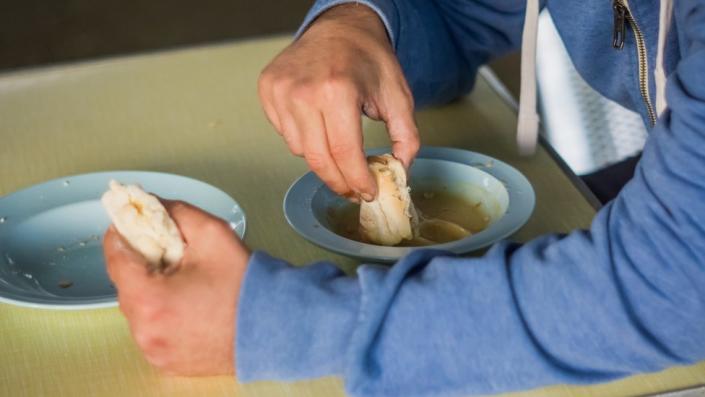
Egg shortages: Warning shortfall could last another year
Some farms have begun re-stocking flocks of hens, but a pause in production is expected to continue.
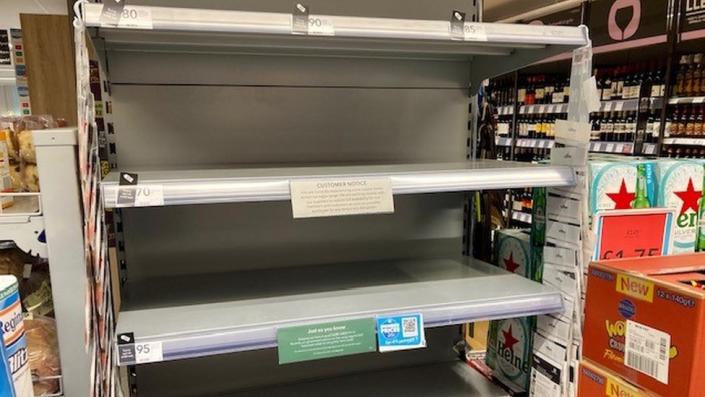
Shoppers may see egg shortages on supermarket shelves for another year, a farmer has warned.
Llyr Jones, whose 32,000 hens supply Tesco, said factors including soaring energy prices last year meant some farmers left the industry.
He said it would take time for it to return to "normality" now farmers have started re-stocking flocks.
Farming union NFU Cymru warned that egg production "is not a simple switch on, switch off system".
Mr Jones' hens currently produce just over 31,000 eggs per day from Derwedd Farm in Llanfihangel Glyn Myfyr, Conwy.
Last year his feed bills rose from £30,000 a month to £50,000 due largely to the invasion of Ukraine, which is a major producer of the corn used for bird feed.
Mr Jones said a rise in energy bills, the outbreak of bird flu, and the desire for less caged hens have also proved obstacles.
He said the supermarkets were initially reluctant to pay farmers more for their eggs, which made some quit the industry, while others chose not to re-stock their flocks.
Mr Jones said: "A lot of farmers decided not to re-stock and that then put pressure on the market and the price of eggs was forced up.
"Now, this year, egg prices have increased for us as farmers and thankfully our costs have started to fall a bit, so we're having to recuperate the money that we lost last year."
Although farmers who decided not to re-stock were now putting in orders for new hens, getting hens back on farms takes nearly eight months and then another two months to get them producing eggs.
"So, you're nearly a year until a farmer, from when he's empty, to when he can produce eggs. Now egg prices have gone up, some farmers are buying hens in now, but those eggs won't be on the market for another year," he said.
"So, just bear with us for a bit."
Customers may start seeing more white eggs because some farmers replaced their flocks with white hens, he said, which are more productive than brown egg-laying hens.
But Mr Jones said customers should not notice a difference in quality or taste.
"An egg is an egg. It doesn't matter what colour it comes in," he said.
Mr Jones said that adding to a shortage was that egg consumption is growing in the UK by about 3% a year.
"We're in a cost of living crisis so eggs are one of the cheapest proteins you can buy at the moment," he said.
The UK government pledged to put greater emphasis on farmers' interests in future trade deals and said it would review horticulture and egg supply chains to "ensure farmers get a fair price for their produce".
Recent Defra figures show egg production is down by 2.9% in England in Wales in just three months - to 121 million dozen.
Production is down by nearly a quarter compared to the first three months of 2022 (24.6%).
This is the lowest amount produced on record, according to the Defra figures, which cover January to March 2023.
Meanwhile, egg imports are up 11% compared to the same period last year.
Geraint Hughes, agri-food consultant for Lafan Consulting, said: "Maybe what this has shown is the lack of flexibility within the supermarkets to react quickly to sudden increases in cost.
"We've had decades of small inflationary pressures in the food industry… which allowed supermarkets to do 12 month contracts. Well, now these sudden increases in costs means they should really respond within a matter of days and weeks.
"That's a big structural challenge for the industry."
Mr Hughes said part of the answer was to try and deliver policies and mechanisms to encourage shoppers to buy more local, so the industry was less reliant on "global factors".
Brendan Markland, who is on holiday on Anglesey with his son Jonathan, said they had brought eggs with them all the way from Shropshire to have for their breakfast on Tuesday morning.
"So if that doesn't tell you there's a shortage, nothing does," he said.
Margaret Hall, from Amlwch, said: "In Amlwch they're very scarce. I've always lived on a farm and I always had my own chickens, so it's handy."
Her daughter-in-law Sandra Hall, said: "There's been a great shortage for some reason and we don't know why. We don't use that many, but when you need eggs you need eggs."
NFU Cymru policy adviser Dafydd Jarrett said egg producers were at the mercy of wholesalers and retailers to signal that they required their products.
"Egg production, like any food production system is not a simple switch on, switch off system," he said.
"Any disruption to primary producers in the food supply chain, as has happened recently, takes time to readjust."
New flock of feathered friends for 'heartbroken' pupils
A school targeted by bird thieves welcomes 20 new budgerigars to its aviary.
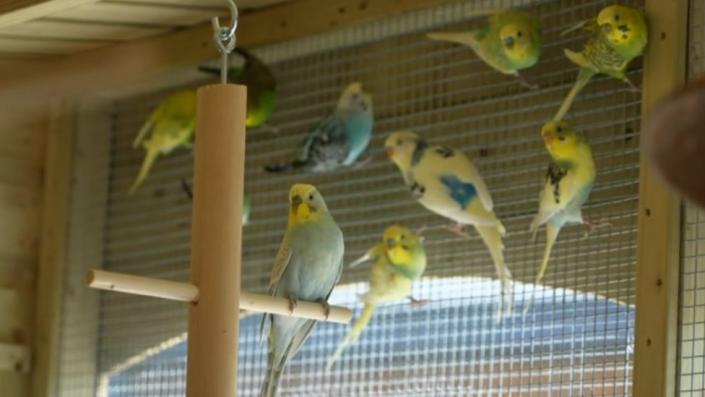
Pupils left heartbroken when thieves broke in and stole their budgies have welcomed a new flock to their school.
Brentry Primary School in Bristol has been given 20 replacement budgies along with a new aviary thanks to community fundraising after the school break-in.
Two thieves were spotted on CCTV in March raiding the bird house at night and capturing the flock.
"I was heartbroken, but now to have the chirping every morning again will bring a smile to my face," said Sasa, age 11.
Speaking in March, Business Manager Hannah Jack, said they just wanted their budgies to be returned because they did not have a great monetary value but held "massive sentimental value" for the children and school community.
The school took in its first budgie seven years ago, when pupils cared for a sick bird found stuck in one of the drains on site.
Staff and pupils nursed the bird back to health and built an aviary for it to live in.
Other budgies owned by a neighbour were rehomed at the school and they began to breed, growing to a population of 20.
"We had them for quite a long time," said Minnie, 11, "they were part of our school, so it's really nice to have some more. It completes the school."
The Year Six pupils take responsibility for the budgies, by feeding them daily and cleaning out the aviary.
"It brings a smile to hear that morning tweet and to look at their lovely feathers," said Eliza, age 11.
"It's nice because sometimes you see them playing and they're clumsy and it makes you laugh," she added.
Ms Jack said: " It's the familiarity and the noise which is just so lovely, hearing the chatter as you come up the school drive.
"We are so grateful to everyone for their kind messages and generosity supporting our fundraiser," she added.
Avon and Somerset Police said there had been no significant update on the stolen birds.
Anyone with information about the stolen birds is asked to call the police 101 non-emergency number.
Plans for 5G mast at Edinburgh Castle viewpoint scrapped
More than 320 objections were lodged against the proposed 17m (56ft) structure in the Grassmarket.

Plans for a 5G mast which conservationists said would "damage" an iconic view of Edinburgh Castle have been scrapped following a backlash.
Mobile network Three UK originally said the mast would not spoil the view.
However it has withdrawn its application following a review and said it was trying to find a suitable site.
A spokesperson for Three said: "We want to offer a great network experience in the area and our planners determined that a new site was required to deliver it.
"Following a review, we have withdrawn our application and are working with the city planning team to try to find a suitable location for the mast."
The firm added that 5G rollout is vital for residents, visitors and businesses in the centre of Edinburgh.
The mast was proposed by CK Hutchison Networks to help provide coverage for Three UK's network.
It proposed to build the structure on Johnstone Terrace at the top of Granny's Green Steps - which is just below the castle rock.
Historic Environment Scotland, which manages Edinburgh Castle, said it had not been consulted about the plans.
Many city tours stop in the Grassmarket area so visitors can capture the view looking up at the landmark.
Terry Levinthal, director of Scotland's oldest conservation charity the Cockburn Association, welcomed news of the plans being withdrawn.
On Tuesday, he said: "It has to be appropriate for the place. Some places have 5G masts that are not necessarily pretty, but are not having an impact - but in some places, it is.
"There is is a duty in any planning application to make sure any proposal preserves the character and appearance of the area.
"What we hope for in future is for operators, the city council and other interested parties to sit down and begin thinking of the best way of doing this and what are the sensitive areas."
Mr Levinthal added he was happy to have discussions with companies who wanted to develop in conservation areas.
In Edinburgh alone 50 areas have been granted the status, which recognises parts of special architectural or historic interest.
EU countries adopt law banning products which fuel deforestation
The 27 European Union countries on Tuesday formally adopted new rules that should help the bloc reduce its contribution to global deforestation by regulating the trade in a series of products driving the decrease in forested areas across the world. Under the legislation, companies trading palm oil, cattle, wood, coffee, cocoa, rubber and soy will need to verify that the goods they sell in the EU haven't led to deforestation and forest degradation anywhere in the world since 2021. The regulation also covers derived products such as chocolate or printed paper.
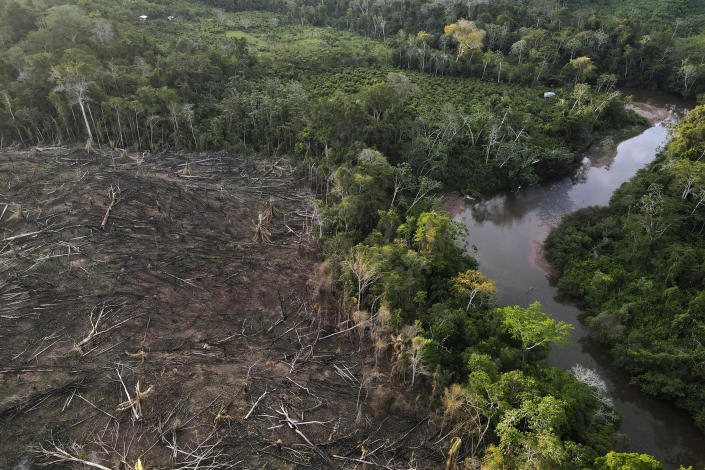
BRUSSELS (AP) — The 27 European Union countries on Tuesday formally adopted new rules that should help the bloc reduce its contribution to global deforestation by regulating the trade in a series of products driving the decrease in forested areas across the world.
Under the legislation, companies trading palm oil, cattle, wood, coffee, cocoa, rubber and soy will need to verify that the goods they sell in the EU haven't led to deforestation and forest degradation anywhere in the world since 2021.
The regulation also covers derived products such as chocolate or printed paper.
Forests are an important natural means of removing greenhouse gas emissions from the atmosphere, since plants absorb carbon dioxide when they grow.
According to the World Resource Institute, a forested area the size of 10 soccer fields disappears in the world every minute and the EU says that without the new regulation it could be responsible for the loss of 248,000 hectares (612,000 acres) of deforestation per year — a surface almost as large as member country Luxembourg.
“Effectively implemented, the law could significantly reduce greenhouse emissions that result from the clearing of tropical forests for food and other commodities," said Stientje van Veldhoven, the World Resource Institute regional director for Europe. “And it could help protect critical biodiversity and water resources in tropical rainforests.”
The law will force companies to show that goods they import comply with rules in the country of origin, including on human rights and the protection of Indigenous people.
Van Veldhoven added that the EU should now cooperate with producing countries to make sure they can adapt to the new legislation without hurting their economies and people's livelihoods.
“This will require incentives for vulnerable groups like smallholder farmers to shift toward deforestation-free practices, ensuring they do not get left behind in this transition,” she said.
Forests around the world are increasingly under threat from clearance for timber and agriculture, including soybean and palm oil. The U.N. Food and Agriculture Organization estimates that 420 million hectares (1.6 million square miles) of forest — an area larger than the EU — were destroyed between 1990 and 2020.
___
___
Associated Press climate and environmental coverage receives support from several private foundations. See more about AP’s climate initiative here. The AP is solely responsible for all content.
Somerset Wildlife Trust celebrates wilder gardens
Plaques are being given to people who allow wildflowers to bloom and cut down weedkiller use.

A nature charity is rewarding gardeners who make space for wildlife.
Somerset Wildlife Trust is giving plaques to people who allow wildflowers to bloom and cut out the use of weedkillers.
It hopes it will inspire others, and this year it is also offering plaques for whole communities making a collective effort to support nature.
Fellow charity Plantlife says it has already seen some bird species increasing thanks to wilder gardening.
Bryony Slaymaker, of Somerset Wildlife Trust, said: "The aim is to give people recognition and to say thank you because gardens are so important and if we all do a little bit it will make a huge difference.
"Behavioural science tells us that if one in four people visibly take action, that encourages everyone else to do things - it tips the balance."
No Mow May, where gardeners do not use their lawnmowers or shears for a month, was launched by Plantlife in 2018, and has been steadily gaining traction.
People can apply for a plaque by filling out a self-assessment survey on the Somerset Wildlife Trust's website with details of their garden's size and the different features they have added.
Those with just a courtyard or window box can join in, and there is also a category for allotments.
This year, for the first time a street, village or an entire town can try to earn a community plaque if enough people start managing gardens and green spaces for wildlife.
Ms Slaymaker said: "This is brand new, no one has got it yet - the plaques aren't even printed out but we would really love to see it."
"It is a big ambition, and it will take local people and community champions getting behind it."
Sarah Shuttleworth, senior ecological advisor with Plantlife, says efforts by individuals and local communities can add up to real policy change.
"If people are changing the way they are managing their own gardens, they are going to start changing their values about how they feel about wildlife everywhere, and that definitely does make a difference," she said.
"If we have this idea of 'I can't do anything because it is such a small amount,' that is not the way we are going to change things in the biodiversity crisis."
Ms Shuttleworth, who is based North Curry, manages some plots of land in the Somerset village and says she has already started to notice the difference.
"I have seen an increase in plant life and an increase in bird species, including predators such as sparrowhawks."
Growing food insecurity a “stinging indictment”
Rising prices, war in Ukraine and trade disruption have increased food insecurity across the world.
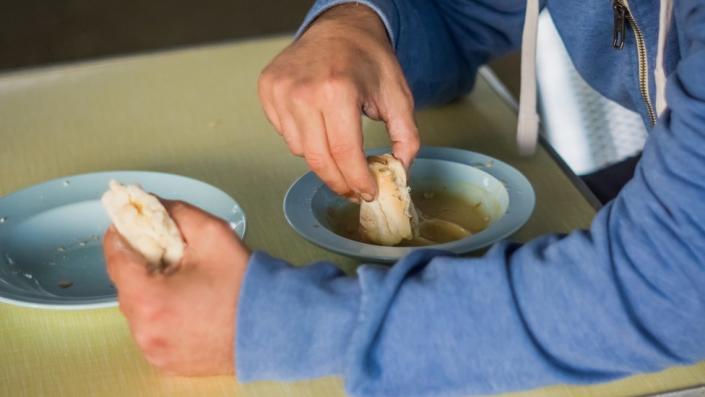
A 'farm-to-fork' summit is aimed at addressing food insecurity in Britain, in response to farmer pressure, sharply increased prices and supply shortages.
In a wider context, United Nations reports show more than quarter of a billion people were facing severe food insecurity last year - an increasing number whose inability to get sufficient food put them in immediate danger.
If one response is to divert valuable grain from resource-intensive livestock farming, there is some reassurance for livestock farmers - the United Nations food agency reckons many women and children need more meat, dairy and eggs in their diet, but warns that farmers have to clean up.
Out of the frying pan and onto the political hotplate: rising prices, war in Ukraine and disruption of trade with Britain's nearest neighbours have together put the heat under food insecurity.
When the meeting was announced, fulfilling a leadership campaign promise to farmers, Minette Batters, president of the National Farmers Union, said: "The past 18 months have been a stark reminder of how vulnerable the nation's food security is.
"It has been a wake-up call for the importance of a secure domestic supply of food, and it is vital that the summit delivers actions, not just words."
On the even of the summit, Downing Street announced measures to tackle disruption in the horticulture and egg sector, using legal powers already deployed with pork and dairy. There are additional funds for promoting exports, including seafood, and tackling obstacles to export in foreign markets.
The prime minister's words make a big promise to producers on future trade policy.
"Farmers' interests will be put at the heart of trade policy," Mr Sunak says, "through a new framework for trade negotiations, committing to protect the UK's high food and welfare standards and prioritise new export opportunities."
Farmers are warning that cheaper imports through those Pacific trade deals, plus a lack of clarity about the future subsidy regime (and this responsibility in Scotland falls to the Scottish government) make us more reliant on imported food, and undermine the job agriculture is doing to look after the countryside.
Of course, food is traded globally and few places, if any, can be entirely self-sufficient. So while we may be rightly concerned about the 19% inflation rate for our grocery food basket, maybe it's time to get some perspective.
First, to point out that we're not alone. Some European countries, including Germany, have even higher food price inflation, but the average for the OECD, the rich country club is lower, at around 15%. The US and Canada are close to 10% food price inflation.
As with energy, most people in such countries are able to switch their spending from non-essentials to cover the extra cost. Even while spending more on food, the average British household is buying less food by volume, with significantly less spending on non-food retail.
Some of that shift is to cheaper cuts of meat or down-market 'value' brands. Some of it could lead to less waste of food.
A minority don't have that flexibility in relatively well-off countries. But what about poorer countries, where huge numbers lack the flexibility to absorb higher food prices?
The Food and Agriculture Organisation (FAO) of the United Nations is a useful source of data and insights. It has recently published several reports of note. One was with a warning about the number of people and countries facing a severe increase in food cost and insecurity.
It said the number of people in that position, and requiring urgent food, nutrition and livelihood assistance, last year increased for the fourth consecutive year. Over a quarter of a billion people were facing acute hunger and people in seven countries were on the brink of starvation.
This does not include the many people with chronic malnourishment. Instead, it is a measure of a person's inability to consume adequate food, so that it puts their lives or livelihoods in immediate danger.
There is a statistical health warning. Some of this growth may reflect an increase in the population analysed.
UN secretary-general Antonio Guterres warned: "More than a quarter of a billion people are now facing acute levels of hunger, and some are on the brink of starvation. That's unconscionable.
"It is a stinging indictment of humanity's failure to make progress towards Sustainable Development Goal 2 to end hunger and achieve food security and improved nutrition for all."
These goals were agreed through the United Nations in 2015, with a goal for achieving them by 2030.
Among the worst affected countries, and with 40% of those in the most at-risk category, were Afghanistan, the Democratic Republic of the Congo, Ethiopia, 21 states within Nigeria and Yemen.
War, including civil conflict, plays a part in driving up food costs and disrupting agriculture, and was the main driver for an estimated 117 million people facing food insecurity.
The FAO has since published a separate report warning that a particularly worrying type of locust has arrived in Afghanistan, deepening its troubles.
Other acute problems exist in Somalia, Haiti, Burkina Faso and South Sudan.
In 30 of the world's worst hit crisis areas, over 35 million children under the age of five suffered from wasting or acute malnutrition, with 9.2 million of them suffering from severe wasting, the most life-threatening form of undernutrition and a major contributor to increased child mortality.
Extreme weather was the main cause of food insecurity for 57 million people, including those facing drought in the Horn of Africa and southern Africa, with devastating floods in Pakistan and cyclones in other countries.
A major cause of food insecurity far from the battlefront was war in Ukraine, estimated as the main cause for 84 million people in 27 countries.
It sharply pushed up prices of traded grains and cooking oil, and while that hit relatively well-off nations, the poorest countries were at the end of the queue for scarce resources.
The FAO has an index of traded food commodities, which soared just after the Russian invasion of Ukraine, and then fell every month until last month, when it ticked upwards again.
Compared with April last year, the FAO food price index was 19.7% down, but it was still 5.2% higher than in April the previous year.
This is where the news looks less grim. With Ukrainian grain able to enter world markets through safe passage in the Black Sea, the disruption is seen as being less of a problem.
And although the cost of fertiliser rose steeply last year, much of it coming from Russia, the impact of its reduced use on crop yields does not seem to be disrupting world markets as much as some had feared.
This year's wheat harvest is forecast to reach 785 million tonnes, the second highest on record, beaten only by last year's crop. Maize is expected to see a bumper harvest in Brazil, not so much in Argentina, while South Africa's output is looking strong.
The sugar price index was up nearly 18% in April, reaching its highest level for 12 years due to reduced expectations of harvests in Asia and the European Union. In the UK, the Office for National Statistics says the price of retailed sugar is up by 42%.
That is caused by dry weather conditions, and is also pushed higher by a rise in the international price of crude oil.
Crude oil!? Yes, when that price goes up, there's a stronger financial case for diverting sugar production into the manufacture of ethanol as a substitute for oil.
Before long, the world's aviation industry is also going to be competing for agricultural grain output to fuel aircraft, and reduce its carbon footprint.
The global meat price index also rose last month, driven by pig and poultry prices, as Asian demand increased and animal health worries curbed some production. Beef prices rose as the number of cattle being sold for slaughter fell, especially in the USA.
While other major commodities continued to decline in price, the FAO says one to watch is rice - a staple for many of the world's poorest people. Harvests were hit by higher input costs and adverse weather, as Asian import demand increased.
Under pressure, some governments choose to limit or ban food exports, contributing to a forecast fall in internationally traded rice of more than 4% this year.
The FAO's chief economist, Maximo Torero said: "The increase in rice prices is extremely worrisome and it is essential that the Black Sea initiative (allowing Ukrainian exports) is renewed to avoid any other spikes in wheat and maize".
One answer to food shortages and insecurity is to redeploy a lot of grain and fishmeal from producing meat, with the argument that it is a highly resource-intensive and inefficient way to get the protein people need and so many millions of people lack.
It's a subject that gets livestock farmers riled up, notably in places - including much of Scotland - where there's not a lot you can do with land other than put sheep on it.
That's where another recent FAO report comes in. Published late last month, it addresses the question of whether meat, dairy and eggs are required in the human food chain.
The report claims to be the most comprehensive analysis so far of the benefits and risks of consuming animal source food, drawing from more than 500 scientific papers and 250 policy documents.
The reliability of the source of such papers is open to dispute, where vested interests in the food industry have a lot of influence. But the conclusion is that "meat, eggs and milk offer crucial sources of nutrients which cannot be obtained from plant-based foods".
Or to be more precise, they cannot be obtained in sufficient quality and quantity. This is particularly important during pregnancy, lactation, childhood, adolescence and older age, the study claims.
Iron, zinc and vitamin A are notably absent from too many children and pregnant women, it says, affecting more than half of pre-school children and 1.2 billion women of child-bearing age.
Three-quarters of these children live in south and east Asia, sub-Saharan Africa and the Pacific.
The report demonstrates how widely varied is the use of meat and dairy in diets. A person in the Democratic Republic of the Congo consumes on average only 160 grams of milk a year, while someone in Montenegro consumes 338 kilograms.
A person in South Sudan consumes 2 grams of eggs on average each year, compared to an average 25kg for a person in Hong Kong. The average person in Burundi consumes just 3 kg of meat a year, compared to 136 kg for someone living in Hong Kong.
Not such good news for meat producers is the conclusion that processed red meat, even in small quantities, is linked to increased risk of chronic disease and early death. But unprocessed red meat, in moderation, has not been shown to carry those risks.
Better news still for the world's livestock farmers is the FAO conclusion that evidence of links to common life-threatening conditions such as heart disease, strokes and hypertension are inconclusive for milk and not significant for eggs and poultry.
But the critics of meat production get more support on other fronts, with reminders that the industry has big challenges if it is to reduce the environmental impact of deforestation to clear land for grazing, of greenhouse gas emissions from animals, of unsustainable water and land use, and of pollution from intensive farming.
There are also social issues, of the fairness of a food production system that uses so much to make protein for richer countries, while others find grain prices getting out of reach.
Food insecurity is rarely a problem of insufficient food. It is more often a problem of affordable food, and how it is distributed… which brings us round the world and back - with some more perspective, I hope - to that "farm-to-fork summit" of government leaders and food producers in Downing Street.
0 Likes
